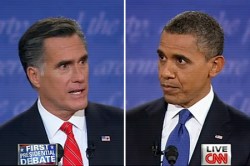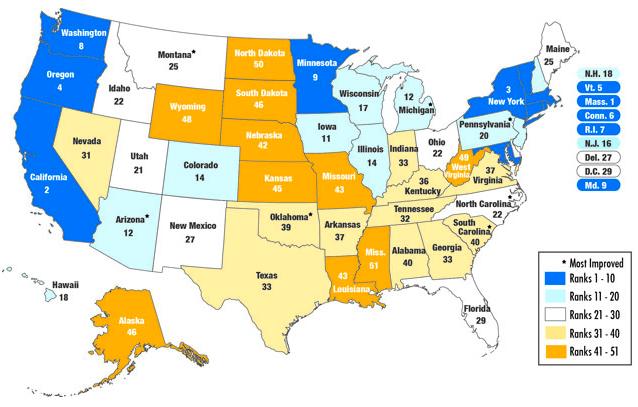
CNN
Big Bird might have been one of the most popular trends on Twitter during the first presidential debate between Mitt Romney and Barack Obama. But as the discussion of domestic issues unfolded, #climatesilence got some play as well. Sadly, not because the candidates broke their silence on the issue.
Here are two tweets that summed up the lack of attention to climate change:

And this one from climate activist Bill McKibben:
 If you watched the real-time reaction to the debates, the disappointment among folks within the energy and environment community over the lack of attention to climate was palpable. Even with 160,000 signatures delivered to PBS’s Jim Lehrer calling on him to ask the candidates about climate change, the issue was completely ignored during the 90-minute conversation — continuing a long streak of silence throughout the campaign.
If you watched the real-time reaction to the debates, the disappointment among folks within the energy and environment community over the lack of attention to climate was palpable. Even with 160,000 signatures delivered to PBS’s Jim Lehrer calling on him to ask the candidates about climate change, the issue was completely ignored during the 90-minute conversation — continuing a long streak of silence throughout the campaign.
Apparently, neither of the candidates has been watching the polls showing that climate could be a major factor in how undecided and independent voters cast their ballots.
Energy issues were sprinkled throughout the debate, however. The mentions were focused mostly on domestic drilling and clean-energy spending.
Obama stuck to his talking points about developing “new sources of energy,” repealing billions in tax credits for the oil and gas industry, and supporting an “all of the above” energy strategy. He made fluffy statements about supporting clean energy, but no specific claims that called for fact checking.
Romney, on the other hand, made a number of more specific, misleading, and inaccurate statements on the issues:
1. “[G]asoline prices have doubled under the president.”
When Obama came into office, he was dealing with the impact of the greatest financial crisis and economic collapse since the Great Depression. That’s why gas prices were so low; demand had declined substantially. Even the Cato Institute and The Wall Street Journal have pointed out this obvious fact: “When Mr. Obama was inaugurated, demand was weak due to the recession. But now it’s stronger, and thus the price is higher.”
Here’s a chart that shows what happened to gas prices during the recession:

And as many analysts have pointed out, presidents have little control [PDF] over oil and gasoline prices: Oil prices are set on the global market, which is controlled by the Organization of Petroleum Exporting Countries, a cartel. High oil prices are responsible for high gasoline prices: The cost of crude oil accounted for 64 percent of the cost of a gallon of gas in September 2012.
2. “[A]ll of the increase in natural gas and oil has happened on private land, not on government land.”
Under Obama, domestic energy production has soared: The number of oil drilling rigs has quadrupled in number over the past three years. This has brought U.S. oil imports to the lowest level since 1996. And the Congressional Research Service issued a report [PDF] showing that oil production on federal lands was up slightly in 2011 compared to 2007. In addition, the oil and gas industry is sitting on more than 7,000 approved permits [PDF] to drill on public and Indian land, but companies haven’t yet begun exploring or developing those areas.
3. “[A]bout half of [the clean energy companies that] have been invested in [via the stimulus bill] have gone out of business.”
This is blatantly false. In this statement, Romney is conflating the Department of Energy’s loan-guarantee program with all clean energy companies economy-wide. And even when isolating the loan-guarantee program that supported the bankrupt solar company Solyndra, an independent investigation led by Sen. John McCain’s former finance chairman found that these investments will cost $2 billion less than initially expected. That’s because most of the loan guarantees are going toward companies developing large-scale electricity generation projects with long-term agreements for the energy.
[Editor’s note: Michael Grunwald, who literally wrote the book on the stimulus package, estimates that about 1 percent of the stimulus-funded clean-energy firms failed, not 50 percent. “Seriously, that was the lie of the night,” he said.]
4. “[I]n one year, you provided $90 billion in breaks to the green energy world.”
This is also a piece of masterful spin, though not an outright lie. Since the stimulus package was passed, the Department of Energy has put $90 billion toward grants, loan guarantees, R&D programs, competitive prizes, and demonstration projects — everything we need in order to build a foundation to allow clean energy to scale. They are not all tax breaks and they were not all implemented in one year as Romney claimed. And according to the Government Accountability Office (h/t Washington Post), fossil fuel subsidies outnumbered clean energy investments 4 to 1 before the stimulus package was put in place.
What have these clean energy investments spawned? Renewable electricity production has doubled in the last four years; we’ve built some of the most innovative “first of a kind” renewable energy projects in the world; content sourced from domestic wind manufacturing has doubled; we’ve created more than 100,000 direct and indirect jobs in the solar industry; and we’ve leveraged $100 billion in private investments.
Daniel J. Weiss, a senior fellow at the Center for American Progress Action Fund, contributed to this piece.



